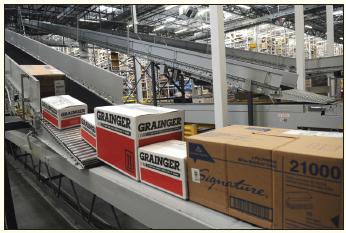W. W. Grainger, Inc., is a leading supplier of maintenance, repair, and operating (MRO) products to businesses and institutions in the United States, Canada, and
W. W. Grainger, Inc., is a leading supplier of maintenance, repair, and operating (MRO) products to businesses and institutions in the United States, Canada, and Mexico, with an expanding presence in Japan, India, China, and Panama. The company works with more than 3,000 suppliers and runs an extensive Website (www.grainger.com), where it offers nearly 900,000 products. The products range from industrial adhesives used in manufacturing, to hand tools, janitorial supplies, lighting equipment, and power tools. When something is needed by one of its 1.8 million customers, it is often needed quickly, so quick service and product availability are key drivers to Grainger’s success.
Your assignment involves studying a specific part of Grainger’s supply chain. Grainger works with over 250 suppliers in the China and Taiwan region. These suppliers produce products to Grainger’s specifications and ship to the United States using ocean freight carriers from four major ports in China and Taiwan. From these ports, product is shipped to U.S. entry ports in either Seattle, Washington, or Los Angeles, California. After passing through customs, the 20- and 40-foot containers are shipped by rail to Grainger’s central distribution center in Kansas City, Kansas. The containers are unloaded and quality is checked in Kansas City. From there, individual items are sent to regional warehouses in nine U.S. locations, a Canadian site, and Mexico.
The Current China/Taiwan Logistics Arrangement
The contracts that Grainger has with Chinese and Taiwanese suppliers currently specify that the supplier owns the product and is responsible for all costs incurred until the product is delivered to the shipping port. These are commonly referred to as free on board (FOB) shipping port contracts. Grainger works with a freight forwarding company that coordinates all shipments from the Asian suppliers.

© Debbie Noda/Modesto Bee/ZUMAPRESS/Alamy
Currently, suppliers have the option of either shipping product on pallets to consolidation centers at the port locations or packing the product in 20- and 40-foot containers that are loaded directly on the ships bound for the United States. In many cases, the volume from a supplier is relatively small and will not sufficiently fill a container. The consolidation centers are where individual pallets are loaded into the containers that protect the product while being shipped across the Pacific Ocean and then to Grainger’s Kansas City distribution center. The freight forwarding company coordinates the efficient shipping of the 20- and 40-foot containers. These are the same containers that are loaded onto rail cars in the United States.
Currently, about 190,000 cubic meters of material are shipped annually from China and Taiwan. This is expected to grow about 15 percent per year over the next five years. About 89 percent of all the volume shipped from China and Taiwan are sent directly from the suppliers in 20- and 40-foot containers that are packed by the supplier at the supplier site. Approximately 21 percent are packed in the 20-foot containers and 79 percent in 40-foot containers. The 20-foot containers can hold 34 cubic meters (CBM) of material, and the 40-foot containers, 67 CBM. The cost to ship a 20-foot container is $480, and for a 40-foot container, $600; this is from any port location in China or Taiwan and to either Los Angeles or Seattle. Grainger estimates that these supplier-filled containers average 85 percent full when they are shipped.
The remaining 11 percent shipped from China and Taiwan go through consolidation centers that are located at each port. These consolidation centers are run by the freight forwarding company and cost about $75,000 per year each to operate. At the volumes that are currently running through these centers, the variable cost is $4.90 per CBM. The variable cost of running a consolidation center could be reduced to about $1.40 per CBM using technology if the volume could be increased to at least 50,000 CBM per year. Now there is much variability in the volume run at each center and it only averages about 5,000 CBM per site.
Material at the consolidation centers is accumulated on an ongoing basis, and as containers are filled they are sent to the port. Volume is sufficient enough that at least one 40-foot container is shipped from each consolidation center each week. Grainger has found that the consolidation centers can load all material into 40-foot containers and utilize 96 percent of the capacity of the container.
Grainger ships from four major port locations. Approximately 10 percent of the volume is shipped from the north China port of Qingdao, while 42 percent is shipped from the central China port of Shanghai/Ningbo. Another 10 percent is shipped from Kaohsiung in Taiwan. The final 38 percent is shipped from the southern Yan-tian/Hong Kong port. Consolidation centers are currently run in each location.
Grainger management feels that it may be possible to make this part of its supply chain more efficient.
Evaluate an alternative that involves consolidating all 20-foot container volumes and using only a single consolidation center in Shanghai/Ningbo. Assume that all the existing 20-foot container volumes and the existing consolidation center volumes are sent to this single consolidation center by suppliers. This new consolidation center volume would be packed into 40-foot containers, filled to 96 percent, and shipped to the United States. The existing 40-foot volume would still be shipped direct from the suppliers at 85 percent capacity utilization.
GRAINGER GRAINGER 21000 GRAINGER gounture,
Step by Step Solution
3.43 Rating (150 Votes )
There are 3 Steps involved in it
Step: 1

See step-by-step solutions with expert insights and AI powered tools for academic success
Step: 2

Step: 3

Ace Your Homework with AI
Get the answers you need in no time with our AI-driven, step-by-step assistance
Get Started


